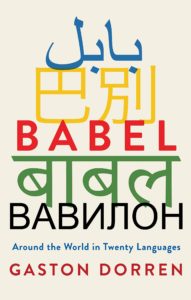In a tour of the world’s powerhouse languages, a focus on Arabic is an absolute must. I was initially a little intimidated by this being the first language I’ve covered that doesn’t use the Latin alphabet. (Swahili used to use the Arabic script but later converted.) Then I remembered that I’m writing in English. So here are 10 things you should know about the Arabic language. As usual, one of my favorite books about language, Babel, helped out a lot.
1
Arabic emerged early in the Common Era on the Arabian Peninsula and owes its name to nomadic tribes (Arabs) in the region. Islam came to prominence in the same region in the sixth and seventh centuries, and the Islamic conquests of the seventh century spread Arabic throughout the Middle East, North Africa, and the Iberian Peninsula.
2
Arabic is in the group of Semitic languages within the larger Afro-Asiatic language family. Other Semitic languages include Amharic (think Ethiopia), Hebrew (think Israel), and Maltese (think Malta) among many others.
3
Pinpointing the number of speakers is hard for any language, and it’s particularly hard for Arabic. Modern Standard Arabic is the language used in books, schools, and the media. It is typically spoken in formal situations and is not a true mother tongue for anyone. The Arabic that is actually spoken day to day is technically a macrolanguage that consists of perhaps 30 different varieties. These “dialects” can occasionally vary to the point of being mutually unintelligible. By lumping them into one category, the result is over 400 million Arabic speakers, making the language the fifth most spoken in the world.
4
Modern Standard Arabic is an official language in 23 sovereign nations: Algeria, Bahrain, Chad, Comoros, Djibouti, Egypt, Iraq, Jordan, Kuwait, Lebanon, Libya, Mauritania, Morocco, Oman, Palestine, Qatar, Saudi Arabia, Somalia, Sudan, Syria, Tunisia, United Arab Emirates, and Yemen. The largest of these by population is Egypt (about 104 million), and Saudi Arabia has the highest nominal GDP (19th in the world).
5
Modern Standard Arabic is a modernized version of seventh century Koranic Arabic. The latter is believed by devout Muslims to be the language in which God chose to reveal the Koran to Muhammad. Non-Arabic-speaking Muslims typically know a little Koranic Arabic.
6
Arabic is one of the three most-spoken Middle Eastern languages. Also on the list is Persian (or Farsi), an Indo-European language with about 110 million speakers and official status in Iran, Afghanistan (Dari variety), and Tajikistan (Tajik variety). Turkish, a Turkic language with about 90 million speakers and official status in Turkey and Cyprus, rounds out the group.
7
The Arabic script is written from right to left in a cursive style. It is used as the primary script for many languages, making it the third most-used script by number of users behind the Latin alphabet and Chinese characters. Numbers in Arabic are read from left to right.
8
Arabic uses a system in which most words are derived from a root (generally three letters). The number of ways in which the root can be modified can get rather large, leaving the number of words in the language up for debate. Estimates vary from a few hundred thousand to a few hundred million, with the consensus being that it doesn’t really matter.
9
Of course, Arabic can be heard in many countries where it isn’t an official language. Arabic has previously been identified as the fastest-growing language in the United States, explaining its ranking as the sixth most-common language spoken at home in the country.
10
As a result of the aforementioned Islamic conquest of the Iberian Peninsula, many Arabic words found their way into Romance languages, which in turn influenced the Germanic language of English. In fact, many common English words have their roots in Arabic, sometimes, of course, passing through other languages. Examples include alcohol, algebra, coffee, magazine, mattress, and sofa.
Needless to say, if you want some bang for your buck in your language learning endeavors, Arabic would be a great choice. Just don’t ask which variety to learn first.
